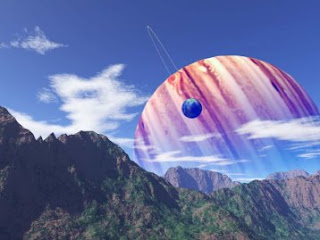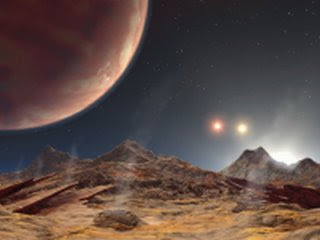Jupiter-Uranus conjunctions occur every 13 years or so, but when there is also a hard aspect to Pluto, as there is now, it is likely to produce more powerful results than usual. The last time this happened was in 1969, with Uranus-Jupiter and Pluto all conjunct: this was when the first man landed on the Moon! The time before that was in 1900, when Uranus was conjunct Jupiter and opposite Pluto, and that year saw both the discovery of quantum energy and the publication of Freud’s The Interpretation of Dreams.
So we can expect something unusually big this year, and it wouldn’t surprise me if it is life on other planets. Or the so-called God particle, the Higgs Boson – though on its own, that wouldn’t be significant enough.
The Kepler Space Telescope was specifically designed to search for exo-planets – planets in other solar systems. It was launched in March 2009, and became operative in May that year. In Feb 2011 NASA announced that they had 1235 planetary candidates circling 997 stars. Of these, 68 are approximately earth sized. Exo-planets were first discovered back in the 1990s, but Kepler has brought about an explosion in their number. It would seem a matter of time before the light signatures of organic molecules associated with life are detected.
Kepler has a powerful chart – Sun-Uranus trine the Moon in its own sign in the 9th House of distant places. Astrologically, the Moon is the nearest planet to earth, and the first planet we have visited. So that’s very appropriate, and the harmony between Sun and Moon suggests success. The Sun is opposite a 10th House Saturn, which shows the ambition behind the project, and its technological nature (Saturn in Virgo). The Sun in Pisces shows the very broad cosmic awareness behind the project, and even the sense of connectedness it may bring. As well as the very sensitive nature of the science involved. Neptune in scientific Aquarius opposite the MC shows the imaginative quest behind the project, a Neptune empowered by a close conjunction to Mars. More broadly, the launch took place under a Saturn-Uranus opposition which, like Jupiter-Uranus, is a time of scientific advance.
Click to Enlarge
In 2007 I posted a piece called Strange New Worlds, describing some of the exo-planets that had been discovered up to that point. It’s very sci-fi, but it’s for real:
We’ve known for a long time of the existence of other Suns like our own, but other planets, other worlds were not definitively detected until early 1992, as the Uranus-Neptune conjunction began. They tend to be detected indirectly through their effect on their local Sun, and naturally enough the ones detected so far are mostly pretty big, because they are easier to spot. These new worlds are known as extra-solar planets, or exoplanets, and there are currently 253 of them.
Some of them are turning out to be weird and wonderful places. Here is a list from New Scientist magazine:
HD189733b (they have such sexy names) is 63 light years away in the constellation Vulpecula, with a mass of 1.15 Jupiters. It orbits its star every 2.2 days. One side is in perpetual daytime, the other side is in perpetual night-time. The day side has a temperature of 940 degrees, the dark side is 700 degrees. The dark side is so hot because winds of more than 10,000 kilometres per hour – Mach 8 – whip round the globe, spreading the heat. In July, it became the first exoplanet to have a compelling case made for water in its atmosphere.

TrES-4 is 1400 light years away in the constellation Hercules. It is the most bloated world on record, less massive then Jupiter but with a volume 5 times bigger. It has an average density less than a wine cork, and would float on water. It orbits its Sun every 3½ days and has a surface temperature of 1300 degrees. It is not known why it is so puffed up, but its days are numbered. Its Sun has run out of hydrogen and in less than a billion years TrES-4 (Doesn’t that name just grow on you?) it will be engulfed by its swelling star.
HD80606b is 190 light years away in the constellation Ursa Major. It is 4 times the mass of Jupiter. Its orbit, which takes 4 months, is wildly elongated, varying from between about 90 million miles and 3 million miles from its Sun. If you floated in its atmosphere, you would see the Sun go from the size of ours to one 900 times as big in just a few days. In the same way, the temperature would soar from about 100 degrees to 1700 degrees. This exoplanet has the most elongated orbit known for any planet, and the reason lies in the gravitational influence of a distant companion star. The orbits of most exoplanets so far have turned out to be much more elongated than those of our local planets, which are nearly circular. This has come as a big surprise.

HD149026b is 256 light years away in the constellation Hercules. It is slightly smaller than Saturn, but has an unusually dense core – packed with about 70 earth masses of heavy elements. Its atmosphere at 2000 C is unbelievably hot – hotter than the surface of some stars, and the hottest planet known. It is so hot because it is close to its star and the planet’s surface is probably very dull-coloured, so it absorbs plenty of light.
Gliese 581 is a dim red dwarf star in the constellation Libra, 20.5 light years away. Earlier this year it was reported that an earth like planet had been discovered circling this star, rocky and with temperatures of around 20C, so liquid water could possibly be present. It has a mass of 15 earths. Then 2 more planets were found orbiting Gliese 581. The smaller one, which is 5 earth masses and a surface temperature of 0 to 40 C, has been dubbed the Goldilocks planet – not too hot for life, not too cold, but just right. Then they reckoned that the greenhouse effect would make the planet far too hot for life. And then they further reckoned that the 3rd planet, of 8 earth masses, which is much further away from the star, might be just the right temperature for life because of the greenhouse effect. These planets will be visible to the European Space Agency’s 3 Darwin spacecraft, due for launch in 2015. They will probe these worlds for signs of life.

PSR B1257+12 is a neutron star, 1.35 times the mass of the Sun, 15km wide (yes, just 15km), 980 light years away in the constellation Virgo. It is the remains of a massive star that exploded in a supernova, leaving a superdense core. This neutron star rotates once every 6 milliseconds, emitting radio beams – in other words, it is a pulsar. It was round this pulsar that the first exoplanets were detected, 0.02, 4.3 and 3.9 times the mass of the earth, while the sizes of their orbits are similar in proportion to those of Mercury, Venus and the Earth. So, remarkably, these first exoplanets are like a carbon copy of our inner solar system, scaled down by a factor of 2. The discoverer reckons the 3.9 earth planet may have an iron core and a strong magnetic field. So that though the pulsar wouldn’t produce much daylight, the planet may well still have magnificent auroras, produced by the dense streams of energetic particles coming off the pulsar, and bright enough to read a book by. The particles would also gradually erode the planet’s surface, generating a low-level haze.



No comments:
Post a Comment